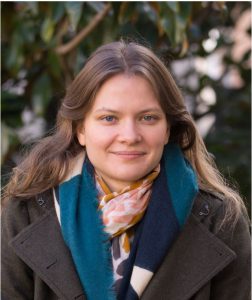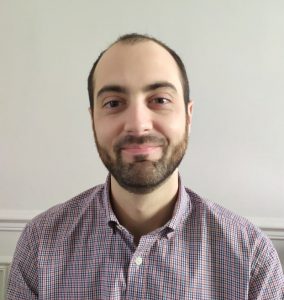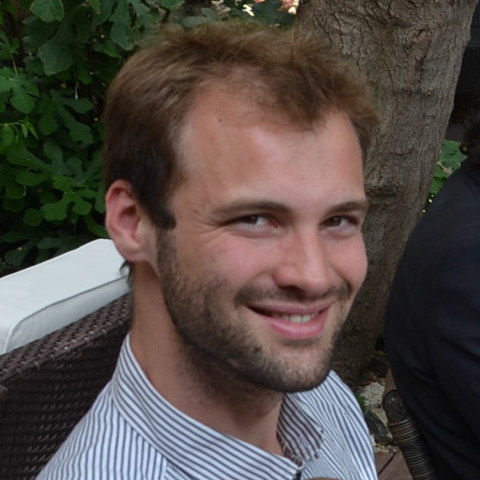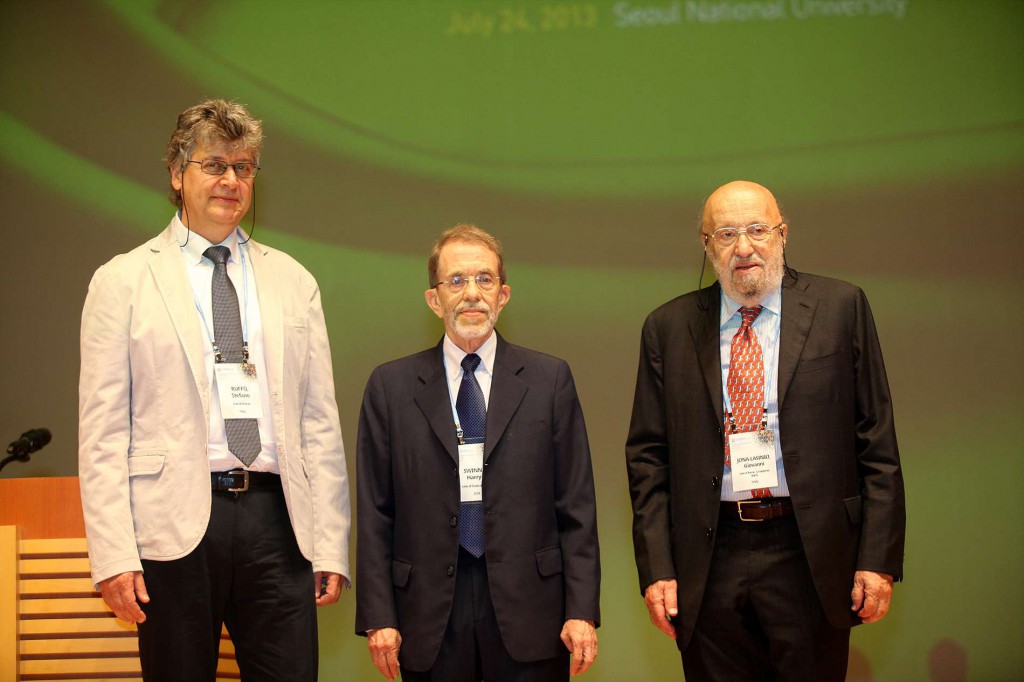
C3: Statistical Physics
The Commission on Statistical Physics (C3) was established by the International Union of Pure and Applied Physics in 1945 to promote the exchange of information and views among the members of the international scientific community in the general field of Statistical Physics.
The C3 Commission is pleased to announce that the Young Scientist Award for 2019 will be awarded during STATPHYS27 to Lucile Savary, Manlio De Domenico and Alexandre Solon.
For her pioneering contributions to our understanding of complex quantum states of matter, with particular reference to quantum spin liquids
Short Biography:
Lucile Savary is a permanent CNRS researcher in condensed matter theory at the Laboratoire de physique at ENS de Lyon. Before moving there, she was a PhD student at the University of California, Santa Barbara, and a Gordon and Betty Moore postdoctoral fellow at MIT.
Her research focuses on exotic phenomena in real systems, with an emphasis on frustrated magnetism. It includes quantum spin liquids, and in particular quantum spin ice, order-by-disorder, quantum criticality, the theory of RIXS, spin-orbital systems, thermal transport, and unconventional superconductivity in multi-band spin-orbit coupled materials.
For his important contributions to the modeling of complex systems based on statistical physics and nonlinear dynamics, in particular, the development of the physics of multilayer networks and a quantum-inspired statistical mechanics of networks.
Short Biography:
De Domenico obtained his PhD in Physics in February 2012 at the School for Advanced Studies of the University of Catania. He is currently Senior Researcher at Fondazione Bruno Kessler – leading Italian research institution – and Director of the Research Unit “Complex Multilayer Networks” (CoMuNe) Lab, an interdisciplinary group working at the edge of Statistical Physics, Applied Math and Computer Science. He holds the National Scientific Habilitation (ASN) as Full Professor in Theoretical Physics of Condensed Matter.
His primary research field gravitates around theoretical and computational aspects of Statistical Physics, with main focus on modeling of complex systems based on statistical physics and nonlinear dynamics. For his recent contributions to the field – including the development of a physics of multilayer networks and a quantum-inspired statistical mechanics of networks – he paved the way for interdisciplinary applications of Statistical Physics to modeling and analysis of the human proteome, the human brain and collective behavior in social and socio-technological systems far from equilibrium.
De Domenico has been recognized by national and international prizes, including the “Junior Scientific Award” from the Complex Systems Society (2016) – for “a number of pioneering contributions to the field of multilayer networks” – and the “Prize in Formal Sciences” from the Universal Scientific Education and Research Network (2017) – for “modeling the complexity of systems of systems”.
Alexandre Solon
For his outstanding theoretical contributions to the development of non-equilibrium statistical physics and the field of active matter.
Short Biography:
Alexandre Solon received in 2015 a PhD in Theoretical Physics from Université Paris-Diderot in which he studied several aspects of the statistical mechanics of active matter under the supervision of Dr. Julien Tailleur. In particular, a large part of his PhD work focused on understanding the transition to collective motion, as exhibited in the Vicsek model, and elucidating the particular properties of the mechanical pressure exerted by active fluids. He was then appointed “Physics of Living Systems” postdoctoral fellow at MIT where he continued his research on active matter and other nonequilibrium systems. His main contributions during this time concern the understanding of motility-induced phase separation and of the optimal thermodynamic protocols minimizing fluctuations. Since October 2018, Alexandre is a CNRS research scientist working in Sorbonne Université in Paris.
——————————————————————————————————————–
The C3 Commission is pleased to announce that the Young Scientist Award for 2016 will be awarded during STATPHYS26 to Lisa Manning and Martin Lenz.
Lisa Manning
In recognition of her outstanding statistical physics contributions to the fields of granular materials, jamming, and biological cell dynamics.
Short Biography:
Manning has become a clear leader in the community studying glassy dynamics and jamming, and has also established the importance of these phenomena to biological tissues. In glasses, she has used random matrix theory to uncover universal vibrational properties, and has identified soft vibrational modes as harbingers of local failure. In biology, she has explored the competition between cell-‐cell adhesion and cortical tension to understand surface tension at the tissue level. Further, she discovered that this competition controls a new rigidity transition in tissues, a startling new member of the jamming transition family that is relevant to asthma and likely also to embryogenesis, tumorigenesis, and wound healing.
For his remarkable creativity in using active processes in living cells as a rich source of new ideas in statistical physics. At the same time, he shows how these ideas can inspire new thinking in biology proper.
Short Biography:
Lenz’ main contributions concern two quite different but ultimately related areas: the structure and dynamics of the cytoskeleton on the one hand, and the mechanics of protein-‐induced remodelling of the cell membrane on the other hand. Both of these problems involve understanding how non-‐equilibrium driving forces establish the structure of the cell. In these problems, the existing knowledge of the biological actors at the molecular scale is still only partial, and Lenz has displayed great subtlety in producing robust theoretical results in sensitive to unknown molecular details.
The Boltzmann Medal
– Boltzmann Ceremony & Presentation: July 24(Wed), 2013
The Boltzmann Award was instituted by the Commission on Statistical Physics (C3) of the IUPAP to honor outstanding achievements in Statistical Physics. It is presented by the Commission at the STATPHYS meeting. The award consists of a glided medal (the Boltzmann Medal) with the inscription of Ludwig Boltzmann.
The C3 Commission is pleased to announce that the Boltzmann Medal has been awarded during STATPHYS25 to:
Giovanni Jona-Lasinio: For his seminal contributions to spontaneous symmetry breaking in particle physics and the theory of non-equilibrium fluctuations.
 Harry Swinney: For his ingenious and challenging experiments which have had a large impact on many areas of statistical physics.
Harry Swinney: For his ingenious and challenging experiments which have had a large impact on many areas of statistical physics.
And the most recent Young Scientist Prize:
 Takahiro Sagawa: For developing a comprehensive theoretical framework to characterize the thermodynamics of nonequilibrium systems with feedback control.
Takahiro Sagawa: For developing a comprehensive theoretical framework to characterize the thermodynamics of nonequilibrium systems with feedback control.
 Kazumasa Takeuchi: For his outstanding experiments on fluctuation properties of growing interfaces in turbulent liquid crystals.
Kazumasa Takeuchi: For his outstanding experiments on fluctuation properties of growing interfaces in turbulent liquid crystals.

Kazumasa Takeuchi (left), recipient of the 2013 IUPAP Young Scientist in Statistical Physics; Stefano Ruffo [Previous Chair, IUPAP Commission C3]; and Takahiro Sagawa, recipient of the 2013 IUPAP Young Scientist in Statistical Physics, at the 25th International Conference on Statistical Physics in Seoul, Korea, 22-26 July 2013.
 IUPAP: The International Union of Pure and Applied Physics
IUPAP: The International Union of Pure and Applied Physics





